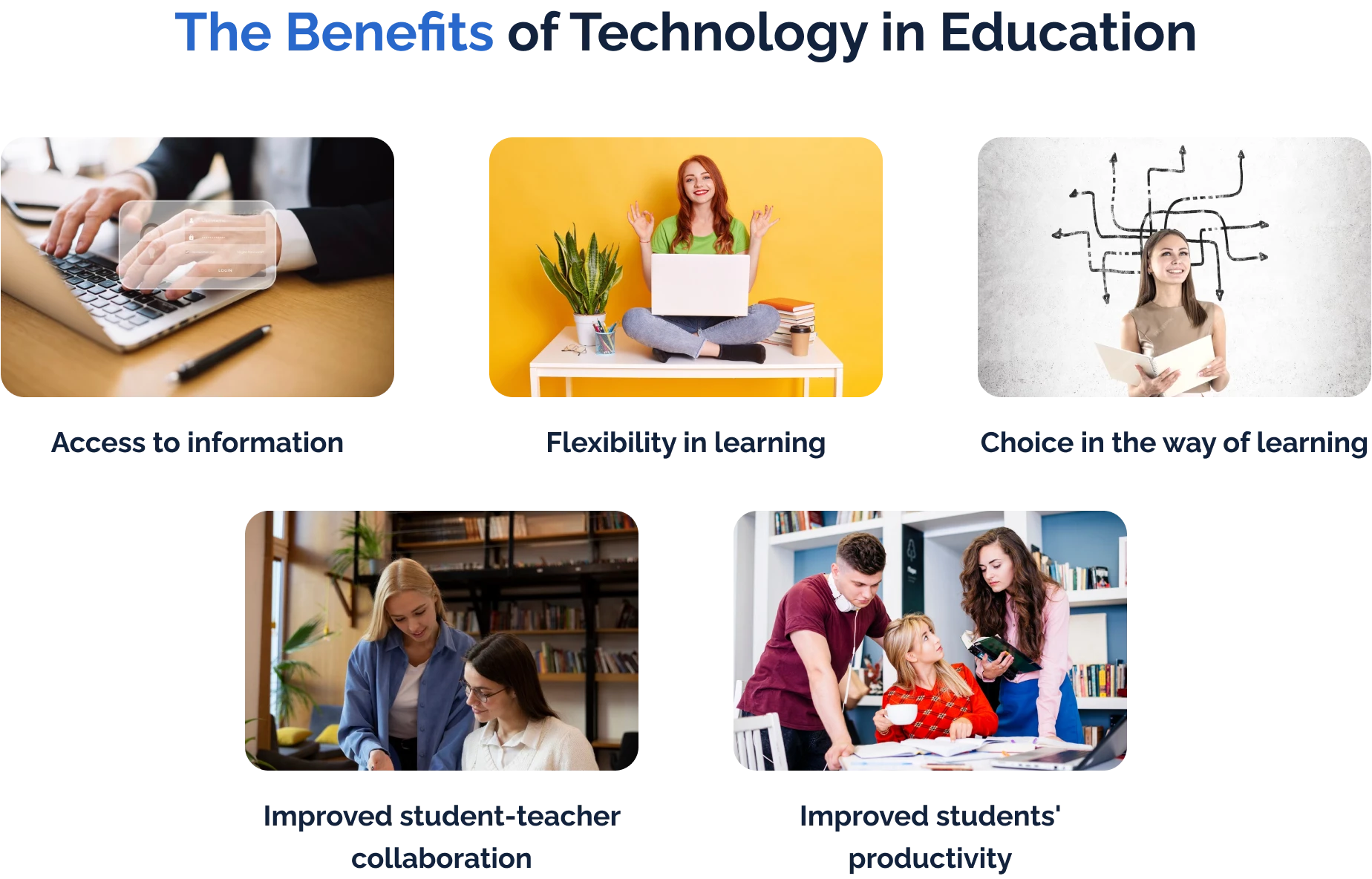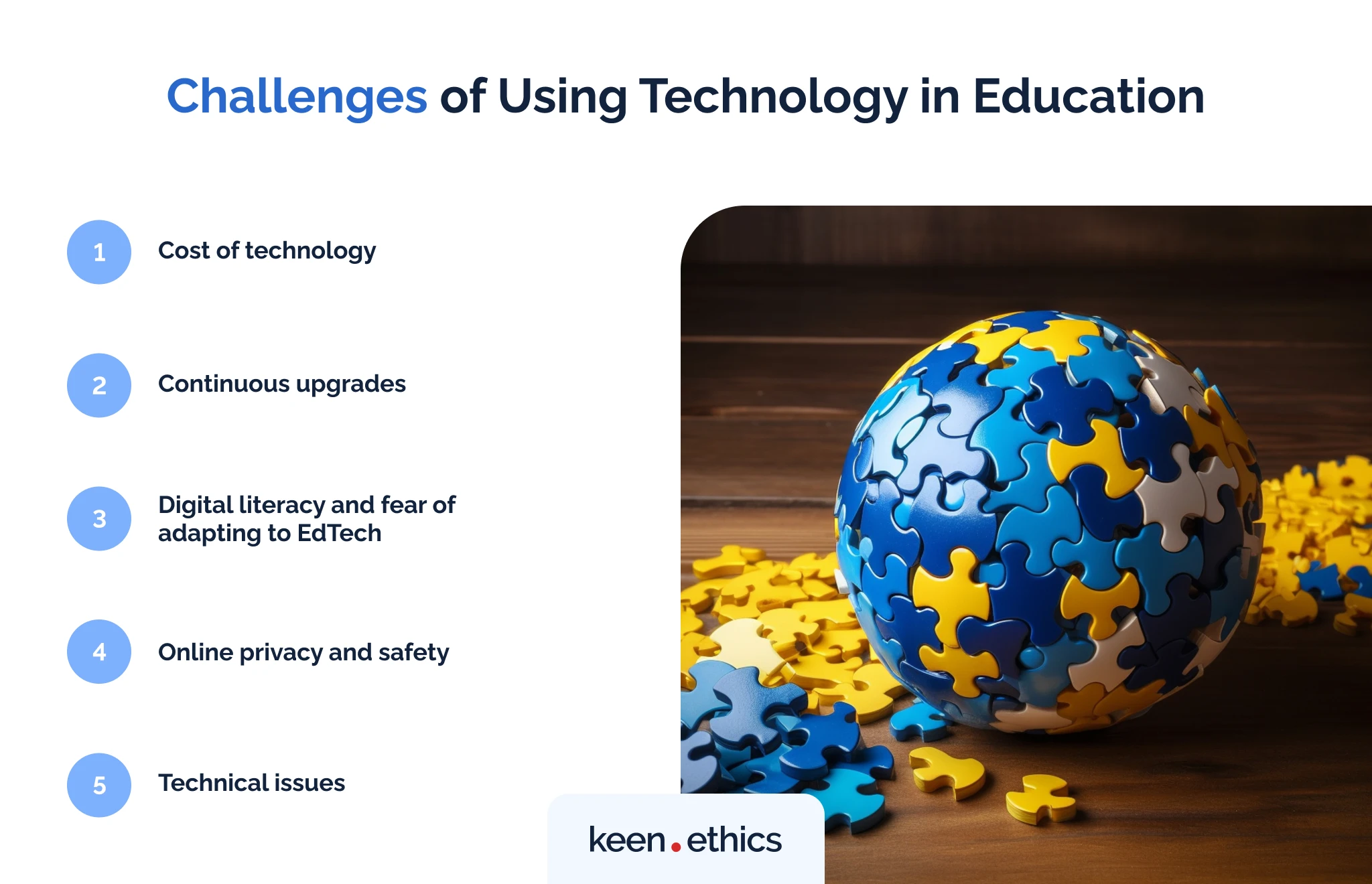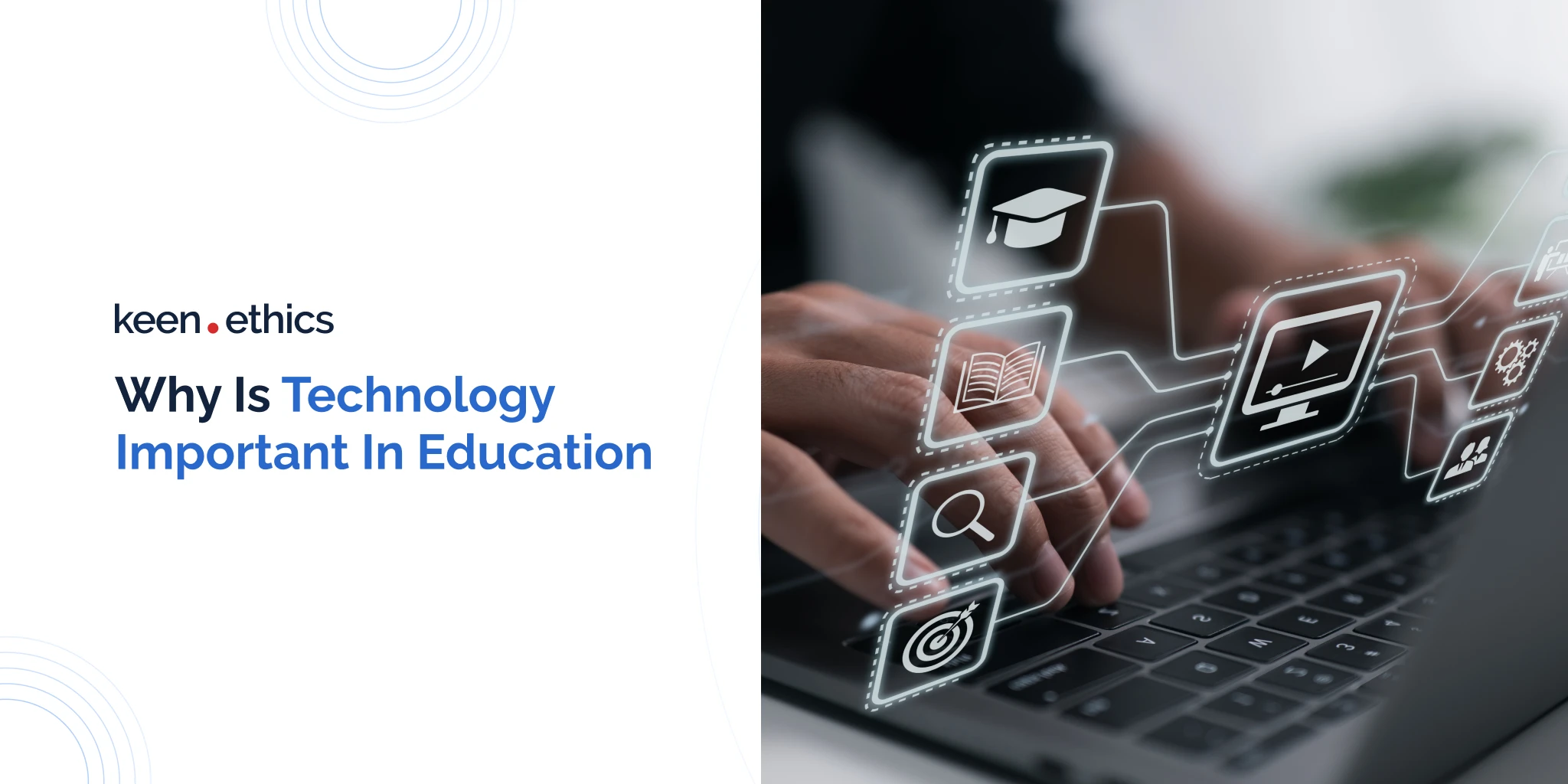Analyze the effectiveness of teaching and learning at your institution. You may find something to change in your educational apps.
The role of EdTech is promising, and as we move further into the 21st century, technology continues to transform academic learning.
- The EdTech market is expected to grow annually by 16.3% and is predicted to grow 2.5x from 2019 to 2025, up to $404B in 2025.
- Among surveyed teachers, 49% believe that technology helps them effectively plan and provide lessons, and 79% of educators report that students’ performance grows when technology is integrated into the classroom.
Educational technology is a mix of computer hardware, software, and tech resources, helping to ease learning. It gives learners more tools to succeed in the classroom and beyond. The goal of EdTech isn’t to replace educators but to complement studying by making it more interactive. It increases the accessibility of education, making remote learning the norm and convenience. In this article, we’ll explore the vital role of technology and how it improves learning experiences.
The Role of Technology in Education
The Internet is full of academic sources, and education is more technologically oriented than recently. Technology has numerous reasons to be a necessity in education. Support for different learning styles, better learner engagement, and preparation for an innovative future underscore its importance.
Why is it important to use technology in education? Thanks to technology, educators can base their programs on virtual methods. For instance, distance learning, supported by Learning Management Systems (LMSs) such as Google Classroom, provides learners a more comprehensive experience. Machine learning and artificial intelligence help teachers avoid excessive control over students’ learning behavior. If you’re interested in the impact of these technologies, we examine the use of machine learning in education and the future perspective for the education sector.
Want to know more about the importance of technology in education? See below.
Offers greater interaction
The best result in learning is when the learner understands the concepts through touch and feelings. They can engage with interactive boards, virtual environments, and educational platforms. Teachers use technology to create interesting lessons and provide instant feedback to students, helping them to improve their performance. With EdTech, the learners’ experience becomes more enjoyable through visualizing complex concepts and doing practical learning activities.
Responds to different learning styles
It’s far easier to use the one-size-fits-all approach, but according to supporters of the VARK model by Neil Fleming, it’s less effective when it comes to the different learning styles of the students. Their strengths, perceptions, and learning techniques differ. We’ll set three categories to see how the technology can respond to learners:
- Auditory learners perceive learning material better through recorded lessons, audiobooks, and podcasts.
- Visual learners better engage with interactive whiteboards, e-books, and visually oriented material.
- Tactile learners learn sufficiently through interactive learning apps and platforms where they can click on mice and swipe screens.
So, what is practical for one category doesn’t work well for another.
Enhances access to resources
Instead of rummaging through stacks of books, learners can access any info through a single resource. Storing and sharing academic materials is easier with EdTech; all information is accessible through digital libraries and online educational apps.
Fosters collaboration
Online forums and e-learning platforms help students work on tasks and projects. Internet connectivity promotes mutual work by connecting students from one class, the whole school, or other cities whose collaboration can be tracked. Learners can chat and share their experiences on social networking platforms. Many apps and sites for student-teacher collaboration encourage teamwork, a valuable skill for the future.
Improves learners’ performance
Some students may be reluctant or introverted to speak with the teachers in front of others. EdTech offers better assessment thanks to instant feedback from the teachers. Teachers can discuss students’ performance through audio and visual files and respond to students’ concerns in real time. EdTech encourages students to interact freely to get more knowledge and use feedback practically to boost their academic performance.
We partly stressed the importance of technology in education, and now we can move on.
The Benefits of Technology in Education

Technology can’t fully replace traditional educational methods, but it prepares students for a tech-paced world when blended with conventional teaching elements.
Let’s study how technology makes learning flexible and fun-filled.
1. Access to information
Technology enriches students’ knowledge and makes them self-sufficient, responsible learners. There is no challenge with searching for info. Only a few click on the laptops or smartphones, and students access any queries from different sources. The Internet provides an ocean of learning material from fresh stats, forums of authors/specialists, and informational websites to tutorials. The only thing left is the desire to learn.
2. Flexibility in learning
Technology offers students flexibility in learning the topic and collaborating with teachers and peers. Now, physical space isn’t a problem. Students can access an e-learning platform and collaborate on projects no matter the distance. Technology fosters social engagement and the exchange of diverse perspectives.
3. Choice in the way of learning
Teachers can apply interactive technology and available multimedia to make the students’ learning more inclusive. With technology, the education sector can provide less text-based material. Video, podcasts, quizzes, and games are modern tech elements fostering teaching and learning to a new level.
4. Improved student-teacher collaboration
Technology offers one-to-one student-teacher interaction. In the case of traditional classrooms, teachers sometimes can’t avoid confusion or loudness. In the case of the virtual classroom, every student can ask questions and be heard by the teacher. Additionally, teachers can create personalized plans according to students’ knowledge levels and interests.
Virtual reality is one of the smart tech solutions taking education to a new level. Recently, we’ve discussed what VR is in education, how it can be used, and how to move from a typical learning experience to exciting learning using VR.
5. Improved students’ productivity
EdTech tools force motivation and creativity. One of these elements is gamification, which is incorporated into educational apps. According to the TalentLMS survey, 84% of respondents are more engaged because of gamification, and 85% believe they would rather use the software if it’s gamified.
The gamified app involves different learning levels accompanied by gamified elements like a collection of coins, reward points, clap sounds, and more. Personalized scoreboards help students compete and outperform peers and be better encouraged to improve. Students are more eager to move to the next level and learn the material in such a game form.
If you want to immerse yourself in the world of education, look at 5 major technology trends in education in 2023.
6. Personalized Learning Experiences
Technology in education is much more than learners plugging into their devices. It’s more about personalized learning, where students know the duty in their progress. They need the agency and skills to engage with the content and be responsible for their learning results. Personalization offers learners a tailored learning path with complete control and guidance through the educational material at their own pace.
Below, you’ll find two ways to innovate the learning process for students. It’s adaptive learning software and AI integration.
A. Adaptive Learning Software and Personalized Curriculums
Adaptive learning is an educational approach that matches the learners’ needs by adjusting the material to the student’s preferences and performance. Thanks to AI and machine learning algorithms, it analyzes learners’ data and provides them with relevant and optimally challenging instructional material. A perfect blend of adaptive and customized learning is when the education program is regularly updated based on students’ goals, backgrounds, and career paths.
In the ’80s, Benjamin S. Bloom researched that students who received personal, one-to-one learning paths outperformed those studying in a traditional, one-size-fits-all learning environment by 98%. Bloom concluded that technology can work just like a tutor, allowing students to overcome all challenges and show excellent study results.
How does adaptive learning resonate with the learners?
1. The adaptive learning forms a single training program with different learning paces. It allows students to reach the same learning outcomes regardless of how fast they perceive the material. The benefit for slower learners is that adaptive learning offers them extra materials if the content isn’t sufficient for them to understand a specific topic.
2. Adaptive learning forms the learners’ needs based on data analytics. It analyzes their learning behavior, collects assessment data, and logs time spent on specific tasks. It detects learning gaps and challenges and forms those patterns needed for the learner’s progress.
3. Adaptive learning defines learners’ challenges in education and, throughout the entire training, repeats the challenging content until everyone masters it.
Educators and students have digital opportunities to switch to adaptive learning systems and adjust unique learning paces. No learner boredom, frustration, and anxiety. Those who quickly absorb the concepts move to the next material. Those who require extra support in comprehending the topic get needed reinforcement.
B. Data Analytics and AI: Tailoring Education to Individual Needs
Another way to let students learn what they prefer is to integrate data analytics and AI. When considering AI in education, the question is about its relevant implementation to be used for the right purposes.
You may think data-directed education isn’t yet spread, but stats show the following. One thousand current undergraduate and graduate students were questioned in a new BestColleges survey. 43% of students had the experience of using AI tools like ChatGPT. Although half of polled admit they used these tools on assignments or exams, it’s far more popular to use AI tools for entertainment. Considering the stats, the students have conscious efforts in their studying, and AI integration won’t defeat the purpose of education if used as a tool for improving content quality and boosting learners’ engagement.
Below are the following ways of data-driven education:
- The use of chatbots is one of AI practical cases in schooling. The University of Murcia in Spain tested an AI chatbot to answer students’ queries. The research showed that the chatbot could answer more than 38,000 questions, answering correctly by 91% over time. Officials found that chatbots not only increased student motivation but also gave educators vast data to analyze. The queries from the students showed real concerns and areas of interest that the educators could use to create innovative services and programs for enhancing the students’ learning experience.
- Staffordshire University in the UK and Georgia Tech in the U.S. rolled out chatbots that answered the most frequently asked questions from the students. Their study showed these chatbots gave educators more time to focus on advancing the learning programs or working on specific research.
- AI provides educators with predictive reports and analytics based on students’ performance. The educators can study potential academic gaps and challenges, predict future outcomes, and support slow learners. AI reports also help educators optimize teaching methods and improve learners’ progress based on their behavior and engagement in learning.
If combining the strengths of AI and human abilities, the results won’t take long. AI algorithms can support optimal learning environments by providing data insights into educational progress.
7. Immersive learning
What’s the core problem of education in the modern world? In our opinion, it’s the lack of immersion. Many people aren’t engaged in learning programs sufficiently. As a result, they face diminished results in college due to, for example, a lack of motivation. In this regard, educational technology is a vital solution to this concern. Why? It can make learning much more immersive. We can note two types of digital tools that are going to be decisive in this field within the next 10 to 15 years. Firstly, we expect that immersive learning will see a major impact from virtual reality. Many colleges and schools are likely to use a range of resources in the VR sector to promote multimodal learning. Secondly, educational technology will bring about a revolution through gamification. Game-based lessons and other activities of this type are highly likely to take over the education sector in the upcoming years.
8. Preparation for a digital-led world
One aspect is clear in the modern world: everything will be digital soon. Even mundane objects such as washing machines are likely to become a part of the digital revolution. Consequently, many people will be unable to fit into the modern world without understanding technology. In this light, the inclusion of technology in education can act as a solution to this problem. By preparing learners to use new tech, we create tremendous opportunities for students in terms of their future adaptation to the world. Individuals who understand the overall principles that govern the behavior of technology are much more likely to adapt to innovations relatively fast. When we offer individual students education centered around technology, we not only improve their learning outcomes. Our investments are also vital to making their lives genuinely better through the acquisition of core skills.
9. Preparation for modern jobs
The majority of jobs on the market are digitalized these days. If you want to pursue a stable career, you should look at the wide range of technologies. In this regard, it’s expected that the average employee should have a strong command of text editors, video applications, and various communication chat apps. Consequently, technology in education includes not only apps aimed at teaching students but also general technology. For example, everyday activities eventually guarantee student mastery over chat apps and some word processors. Even the most basic future career is likely to demand those technologies as a prerequisite. More importantly, they can become a foundation for much more advanced approaches to learning.
10. Improved engagement
In our opinion, the core problem of education is the low engagement of students. We’ve already spoken about motivation. However, there are also additional problems in the education industry that touch upon the interests of people who are invested in learning. In this respect, for example, education technology allows people to bridge vast distances between different countries. As a result, modern learners get an opportunity to study in Ivy League courses from any place in the world. This means that the most advanced lesson plans are no longer the property of the elites alone. People from any place in the world can engage in learning. Such a positive outcome became possible due to the advancement of educational technology such as LMSes and meeting apps.
Challenges of Using Technology in Education

When appropriately implemented, the technology brings benefits. However, there are cases when educators struggle to use the technology to its fullest because of challenges. Let’s examine some of them below.
Cost of technology
Usually, schools have budget limitations, so implementing technology into the classroom isn’t easy. Finding and applying alternative funding sources is important. Despite the cost challenge, the research shows that 92% of organizations are expected to increase their investments in EdTech by 2025.
Continuous upgrades
Technology requires regular updates, which makes it complicated. To keep pace with the current education trends, educators should continuously check the software updates and upgrade or buy new devices to promote a stable learning environment.
Digital literacy and fear of adapting to EdTech
Fear of change is a common concern among teachers. Quick adaptation to a tech environment isn’t easy for educators who used to stick to their teaching methodology and style. First, teachers worry that technology may completely replace them and make them unneeded. Secondly, they need resources and knowledge to implement technology. Therefore, the solution is to provide the teachers with support and proper training so they’ll be confident in applying technology effectively and reap its full benefits.
Online privacy and safety
Inappropriate integration of technology may cause two issues:
- a risk of improper use of data;
- students may become victims of harmful content like violence, hate speech, and cyberbullying.
Technical issues
When integrating EdTech, you automatically get a set of technical issues connected to educational software or devices. However, some solutions can prevent technical problems. Switching to the cloud keeps administrators from using copy machines and buying costly servers for storing material. Upgrading to new devices is another solution for administrators to increase productivity when dealing with slow computers, networks, or printers.
Points to consider:
- While the Internet provides numerous resources, educators should have proper knowledge and training on its relevant application.
- The increased use of technology in classes may lead to students’ dependency on technology. They may not know how to proceed once they encounter glitches connected to technology. A practical solution is to provide a healthy balance between the use of technology and traditional teaching methods to make students less tech-dependent.
If there’s an understanding of how technology can cut costs, reduce educators’ time, and enhance performance, administrators can effectively implement EdTech tools up to any district budget.
Conclusion
Education heavily depends on technology. However, to let everyone use the technology at all levels within the school system, the education sector should address the underlying challenges behind it.
Let’s recap the main points highlighted in this article:
- The role of technology and EdTech tools in enhancing learners’ experience.
- The benefits of technology in the educational sector.
- How to offer personalized learning experience through adaptive learning software.
- In what way the use of data analytics and AI can tailor education to individual needs?
- The main challenges of the effective integration of EdTech.
Adaptive learning holds great potential for changing the future of education. Are you interested in creating a dynamic learning, allowing the learners to possess the necessary skills in the 21st century? Keenethics can help you in finding the best decision for your educational goals.
Do you want to transform the educational methodology in the classroom? We know the challenges the technology can pose in and out of the classroom. Contact us anytime. We’re ready to fully support you with transitioning your classes to an innovative education platform.












